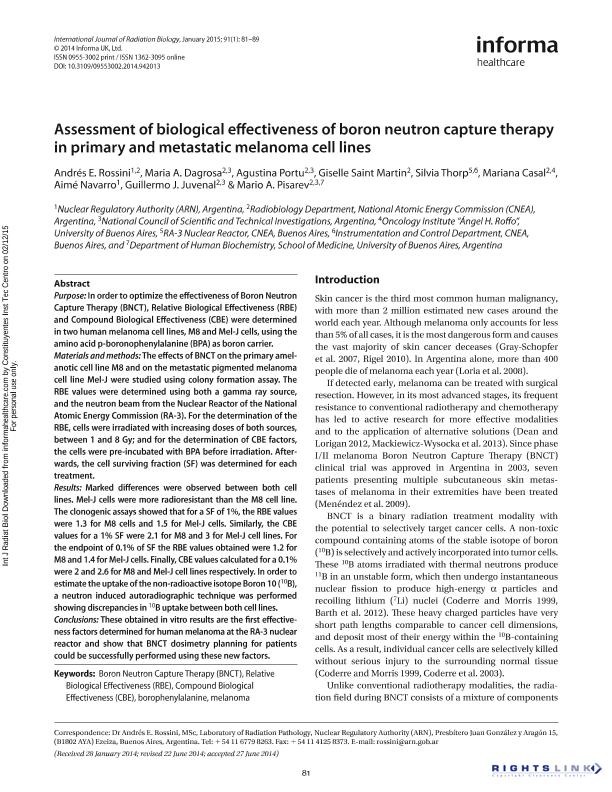Artículo
Assessment of biological effectiveness of boron neutron capture therapy in primary and metastatic melanoma cell lines
Rossini, Andrés Eugenio ; Dagrosa, María Alejandra
; Dagrosa, María Alejandra ; Portu, Agustina Mariana
; Portu, Agustina Mariana ; Saint Martin, María Laura Gisela; Thorp, Silvia Inés; Casal, Mariana; Navarro, Aime; Juvenal, Guillermo Juan
; Saint Martin, María Laura Gisela; Thorp, Silvia Inés; Casal, Mariana; Navarro, Aime; Juvenal, Guillermo Juan ; Pisarev, Mario Alberto
; Pisarev, Mario Alberto
 ; Dagrosa, María Alejandra
; Dagrosa, María Alejandra ; Portu, Agustina Mariana
; Portu, Agustina Mariana ; Saint Martin, María Laura Gisela; Thorp, Silvia Inés; Casal, Mariana; Navarro, Aime; Juvenal, Guillermo Juan
; Saint Martin, María Laura Gisela; Thorp, Silvia Inés; Casal, Mariana; Navarro, Aime; Juvenal, Guillermo Juan ; Pisarev, Mario Alberto
; Pisarev, Mario Alberto
Fecha de publicación:
08/2014
Editorial:
Taylor & Francis Ltd
Revista:
International Journal Of Radiation Biology
ISSN:
0955-3002
Idioma:
Inglés
Tipo de recurso:
Artículo publicado
Clasificación temática:
Resumen
Purpose: In order to optimize the effectiveness of Boron Neutron Capture Therapy (BNCT), Relative Biological Effectiveness (RBE) and Compound Biological Effectiveness (CBE) were determined in two human melanoma cell lines, M8 and Mel-J cells, using the amino acid p-boronophenylalanine (BPA) as boron carrier. Materials and methods: The effects of BNCT on the primary amelanotic cell line M8 and on the metastatic pigmented melanoma cell line Mel-J were studied using colony formation assay. The RBE values were determined using both a gamma ray source, and the neutron beam from the Nuclear Reactor of the National Atomic Energy Commission (RA-3). For the determination of the RBE, cells were irradiated with increasing doses of both sources, between 1 and 8 Gy; and for the determination of CBE factors, the cells were pre-incubated with BPA before irradiation. Afterwards, the cell surviving fraction (SF) was determined for each treatment. Results: Marked differences were observed between both cell lines. Mel-J cells were more radioresistant than the M8 cell line. The clonogenic assays showed that for a SF of 1%, the RBE values were 1.3 for M8 cells and 1.5 for Mel-J cells. Similarly, the CBE values for a 1% SF were 2.1 for M8 and 3 for Mel-J cell lines. For the endpoint of 0.1% of SF the RBE values obtained were 1.2 for M8 and 1.4 for Mel-J cells. Finally, CBE values calculated for a 0.1% were 2 and 2.6 for M8 and Mel-J cell lines respectively. In order to estimate the uptake of the non-radioactive isotope Boron 10 (10B), a neutron induced autoradiographic technique was performed showing discrepancies in 10B uptake between both cell lines. Conclusions: These obtained in vitro results are the first effectiveness factors determined for human melanoma at the RA-3 nuclear reactor and show that BNCT dosimetry planning for patients could be successfully performed using these new factors.
Archivos asociados
Licencia
Identificadores
Colecciones
Articulos(SEDE CENTRAL)
Articulos de SEDE CENTRAL
Articulos de SEDE CENTRAL
Citación
Rossini, Andrés Eugenio; Dagrosa, María Alejandra; Portu, Agustina Mariana; Saint Martin, María Laura Gisela; Thorp, Silvia Inés; et al.; Assessment of biological effectiveness of boron neutron capture therapy in primary and metastatic melanoma cell lines; Taylor & Francis Ltd; International Journal Of Radiation Biology; 91; 1; 8-2014; 81-89
Compartir
Altmétricas



